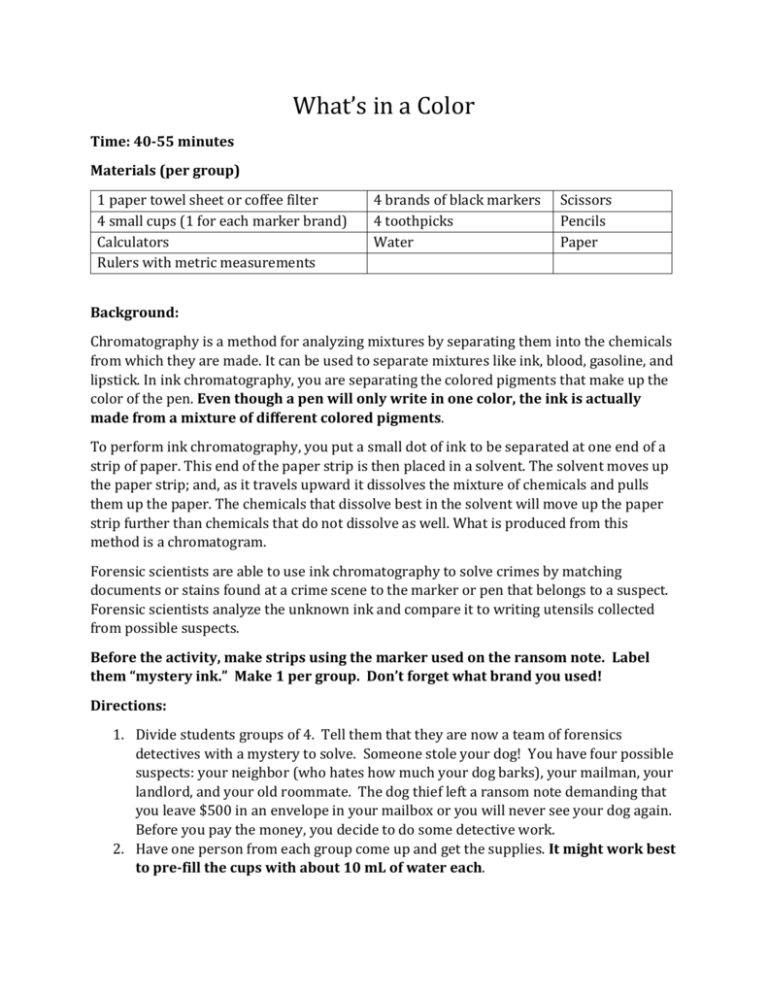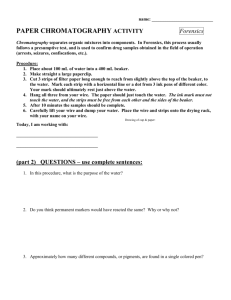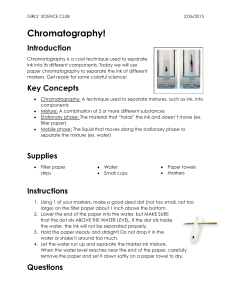What's in a Color?
advertisement

What’s in a Color Time: 40-55 minutes Materials (per group) 1 paper towel sheet or coffee filter 4 small cups (1 for each marker brand) Calculators Rulers with metric measurements 4 brands of black markers 4 toothpicks Water Scissors Pencils Paper Background: Chromatography is a method for analyzing mixtures by separating them into the chemicals from which they are made. It can be used to separate mixtures like ink, blood, gasoline, and lipstick. In ink chromatography, you are separating the colored pigments that make up the color of the pen. Even though a pen will only write in one color, the ink is actually made from a mixture of different colored pigments. To perform ink chromatography, you put a small dot of ink to be separated at one end of a strip of paper. This end of the paper strip is then placed in a solvent. The solvent moves up the paper strip; and, as it travels upward it dissolves the mixture of chemicals and pulls them up the paper. The chemicals that dissolve best in the solvent will move up the paper strip further than chemicals that do not dissolve as well. What is produced from this method is a chromatogram. Forensic scientists are able to use ink chromatography to solve crimes by matching documents or stains found at a crime scene to the marker or pen that belongs to a suspect. Forensic scientists analyze the unknown ink and compare it to writing utensils collected from possible suspects. Before the activity, make strips using the marker used on the ransom note. Label them “mystery ink.” Make 1 per group. Don’t forget what brand you used! Directions: 1. Divide students groups of 4. Tell them that they are now a team of forensics detectives with a mystery to solve. Someone stole your dog! You have four possible suspects: your neighbor (who hates how much your dog barks), your mailman, your landlord, and your old roommate. The dog thief left a ransom note demanding that you leave $500 in an envelope in your mailbox or you will never see your dog again. Before you pay the money, you decide to do some detective work. 2. Have one person from each group come up and get the supplies. It might work best to pre-fill the cups with about 10 mL of water each. 3. Hand out the “mystery ink” strips and tell the students that this is a sample of the marker the thief used to write the note. They have obtained markers from all of the suspects, and will test each marker to see if it matches the note. 4. As a class, decide which marker belongs to which suspect. Write this on the board and have one person from each group record it on their paper. *See the sample table at the end of this packet. 5. Instruct the students to cut four strips of the filter paper, forming a point at one end. Make a large dot (about the size of a grain of rice) about 1.5 cm up from the bottom of the pointed end. Label each paper at the top so you know which marker is which. 6. Use a pencil to make a mark on the paper right next to the ink dot. 7. Lower the pointed end of the paper into the water, making sure the dot stays above the water level. 8. Carefully push a toothpick through the top of the paper so it rests across the top of the cup, holding the strip. 9. Repeat this step for all four markers. 10. When the water has stopped moving up the strip, remove the paper from the cup and immediately mark the highest point that the water has traveled up the paper strip with a pencil. *It will take 3-5 minutes for the water to stop moving up each strip. 11. Lay the strip down to dry. Continue testing until all strips are done. 12. Point out to the students that each brand of marker uses a different combination of colors to produce their black ink. Have the students look closely at each strip and record the colors they can see. Each color represents a different pigment used to make the ink. 13. To prove that the sample from the note is a certain brand, students will also need to calculate the Rf (retention factor) value. Rf compares the distance a pigment traveled up a strip to the distance that the water traveled. To calculate the Rf value: a. Measure the distance in millimeters from the original color dot to the final point that the water traveled (between the two pencil marks). b. Measure the distance in millimeters from the original dot to the highest point of the first colored pigment. c. Measure the distances that any 𝐷𝑖𝑠𝑡𝑎𝑛𝑐𝑒 𝑡𝑟𝑎𝑣𝑒𝑙𝑒𝑑 𝑏𝑦 𝑝𝑖𝑔𝑚𝑒𝑛𝑡 𝑅𝑓 = other colored pigments traveled. 𝐷𝑖𝑠𝑡𝑎𝑛𝑐𝑒 𝑡𝑟𝑎𝑣𝑒𝑙𝑒𝑑 𝑏𝑦 𝑤𝑎𝑡𝑒𝑟 d. Calculate the Rf value. 14. Students should calculate and record the Rf values for all of the strips. 15. Have the students decide who they think the dog thief is. Once all the groups have decided, get a show of hands to show who they think it is. Then reveal the true thief. Sample table—have each group of students create a similar table on their paper. Suspect Sample from note Brand Colors Rf-1 Rf-2 Rf-3






